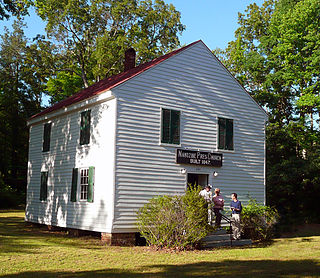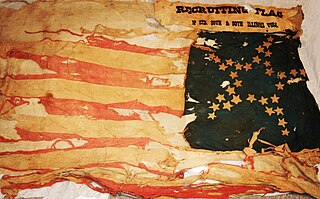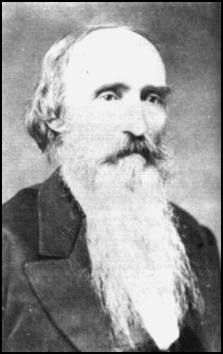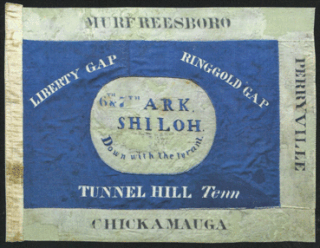
Sherman's March to the Sea was a military campaign of the American Civil War conducted through Georgia from November 15 until December 21, 1864, by William Tecumseh Sherman, major general of the Union Army. The campaign began on November 15 with Sherman's troops leaving Atlanta, recently taken by Union forces, and ended with the capture of the port of Savannah on December 21. His forces followed a "scorched earth" policy, destroying military targets as well as industry, infrastructure, and civilian property, disrupting the Confederacy's economy and transportation networks. The operation debilitated the Confederacy and helped lead to its eventual surrender. Sherman's decision to operate deep within enemy territory without supply lines was unusual for its time, and the campaign is regarded by some historians as an early example of modern warfare or total war.

The Battle of Nashville was a two-day battle in the Franklin-Nashville Campaign that represented the end of large-scale fighting west of the coastal states in the American Civil War. It was fought at Nashville, Tennessee, on December 15–16, 1864, between the Confederate Army of Tennessee under Lieutenant General John Bell Hood and the Union Army of the Cumberland (AoC) under Major General George H. Thomas. In one of the largest victories achieved by the Union Army during the war, Thomas attacked and routed Hood's army, largely destroying it as an effective fighting force.

The Battle of Missionary Ridge, also known as the Battle of Chattanooga, was fought on November 25, 1863, as part of the Chattanooga Campaign of the American Civil War. Following the Union victory in the Battle of Lookout Mountain on November 24, Union forces in the Military Division of the Mississippi under Maj. Gen. Ulysses S. Grant assaulted Missionary Ridge and defeated the Confederate Army of Tennessee, commanded by Gen. Braxton Bragg, forcing it to retreat to Georgia.
The Third Battle of Murfreesboro, also known as Wilkinson Pike or the Cedars, was fought December 5–7, 1864, in Rutherford County, Tennessee, as part of the Franklin-Nashville Campaign of the American Civil War.
The Battle of Utoy Creek was fought August 4–7, 1864, during the Atlanta Campaign of the American Civil War. Maj. Gen. William T. Sherman's Union armies had partially encircled the city of Atlanta, Georgia, which was being held by Confederate forces under the command of General John Bell Hood. Sherman had at this point adopted a strategy of attacking the railroad lines into Atlanta, hoping to cut off his enemies' supplies. This was the third direct attack on Confederate positions during the campaign and the effect of success would have ended the siege and won Atlanta on 6 August 1864.

The Battle of Namozine Church was an engagement in Amelia County, Virginia, between Union Army and Confederate States Army forces that occurred on April 3, 1865, during the Appomattox Campaign of the American Civil War. The battle was the first engagement between units of General Robert E. Lee's Confederate Army of Northern Virginia after that army's evacuation of Petersburg and Richmond, Virginia, on April 2, 1865, and units of the Union Army under the immediate command of Maj. Gen. Philip Sheridan, who was still acting independently as commander of the Army of the Shenandoah, and under the overall direction of Union General-in-Chief Lt. Gen. Ulysses S. Grant. The forces immediately engaged in the battle were brigades of the cavalry division of Union Brig. Gen. and Brevet Maj. Gen. George Armstrong Custer, especially the brigade of Colonel and Brevet Brig. Gen. William Wells, and the Confederate rear guard cavalry brigades of Brig. Gen. William P. Roberts and Brig. Gen. Rufus Barringer and later in the engagement, Confederate infantry from the division of Maj. Gen. Bushrod Johnson.

The Carolinas campaign, also known as the campaign of the Carolinas, was the final campaign conducted by the Union Army against the Confederate Army in the Western Theater of the American Civil War. On January 1, Union Maj. Gen. William T. Sherman advanced north from Savannah, Georgia, through the Carolinas, with the intention of linking up with Union forces in Virginia. The campaign culminated in the defeat of Confederate Gen. Joseph E. Johnston's army at the Battle of Bentonville, and its unconditional surrender to Union forces on April 26, 1865. Coming just two weeks after the defeat of Robert E. Lee's army at the Battle of Appomattox Court House, it signaled that the war was effectively over.

The Battle of Pleasant Hill occurred on April 9, 1864 and formed part of the Red River Campaign during the American Civil War when Union forces aimed to occupy the Louisiana state capital, Shreveport.
Wilson's Raid was a cavalry operation through Alabama and Georgia in March–April 1865, late in the American Civil War. U.S. Brig. Gen. James H. Wilson led his U.S. Cavalry Corps to destroy Confederate manufacturing facilities and was opposed unsuccessfully by a much smaller force under Confederate Lt. Gen. Nathan Bedford Forrest.

James Jay Archer was a lawyer and an officer in the United States Army during the Mexican–American War. He later served as a brigadier general in the Confederate States Army (CSA) during the American Civil War.

The Knoxville campaign was a series of American Civil War battles and maneuvers in East Tennessee during the fall of 1863 designed to secure control of the city of Knoxville and with it the railroad that linked the Confederacy east and west, and position the First Corps under Longstreet for return to the Army of Northern Virginia. Union Army forces under Maj. Gen. Ambrose Burnside occupied Knoxville, Tennessee, and Confederate States Army forces under Lt. Gen. James Longstreet were detached from Gen. Braxton Bragg's Army of Tennessee at Chattanooga to prevent Burnside's reinforcement of the besieged Federal forces there. Ultimately, Longstreet's Siege of Knoxville ended when Union Maj. Gen. William Tecumseh Sherman led elements of the Army of the Tennessee and other troops to Burnside's relief after Union troops had broken the Confederate siege of Chattanooga. Although Longstreet was one of Gen. Robert E. Lee's best corps commanders in the East in the Army of Northern Virginia, he was unsuccessful in his attempt to penetrate the Knoxville defenses and take the city.
Galvanized Yankees was a term from the American Civil War denoting former Confederate prisoners of war who swore allegiance to the United States and joined the Union Army. Approximately 5,600 former Confederate soldiers enlisted in the United States Volunteers, organized into six regiments of infantry between January 1864 and November 1866. Of those, more than 250 had begun their service as Union soldiers, were captured in battle, then enlisted in prison to join a regiment of the Confederate States Army. They surrendered to Union forces in December 1864 and were held by the United States as deserters, but were saved from prosecution by being enlisted in the 5th and 6th U.S. Volunteers. An additional 800 former Confederates served in volunteer regiments raised by the states, forming ten companies. Four of those companies saw combat in the Western Theater against the Confederate Army, two served on the western frontier, and one became an independent company of U.S. Volunteers, serving in Minnesota.

The 80th Illinois Volunteer Infantry Regiment was an infantry regiment that served in the Union Army during the American Civil War. The regiment was composed of ten companies that drew primarily from eight southern Illinois counties. Over the course of the war the regiment traveled approximately 6,000 miles, and was in over 20 battles.

The 12th Iowa Infantry Regiment was an infantry regiment that served in the Union Army during the American Civil War.
The 7th Ohio Cavalry Regiment was a regiment of Union cavalry raised in southern Ohio for service during the American Civil War. Nicknamed the "River Regiment" as its men came from nine counties along the Ohio River, it served in the Western Theater in several major campaigns of the Army of the Ohio.

Claudius Wistar Sears was a United States Army officer, an educator, and a Confederate general during the American Civil War.
The 5th Ohio Cavalry Regiment was a regiment of Union cavalry raised in seven counties in southwestern Ohio for service during the American Civil War. It primarily served in the Western Theater in several major campaigns of the Army of the Tennessee.

The 6th Alabama Cavalry Regiment was a cavalry unit of the Confederate States Army during the American Civil War.

The 7th Arkansas Volunteer Infantry (1861−1865) was a Confederate Army infantry regiment during the American Civil War. Organized mainly from companies, including several prewar volunteer militia companies, raised in northeastern Arkansas, the regiment was among the first transferred to Confederate service, and spent virtually the entire war serving east of the Mississippi River. After the unit sustained heavy casualties in the Battle of Shiloh and the Kentucky Campaign, the unit spent most of the rest of the war field consolidated with the 6th Arkansas Infantry Regiment to form the 6th/7th Arkansas Infantry Regiment.
The 154th Regiment, Tennessee Infantry was an infantry regiment from Tennessee that served with the Confederate States Army in the American Civil War. Raised originally in 1842 as the 154th Tennessee Militia it sought to retain its number and was as such also known as 154th (Senior) Tennessee Infantry . Consolidating with the 13th Tennessee Infantry Regiment in March 1863 it was known as 13th-154th Tennessee Infantry Regiment; and had a number of temporary field consolidations until it was finally merged into the 2nd Consolidated Tennessee Infantry on April 9, 1865. The regiment surrendered with the remnants of the Army of Tennessee at Bennett Place on April 26, 1865.











